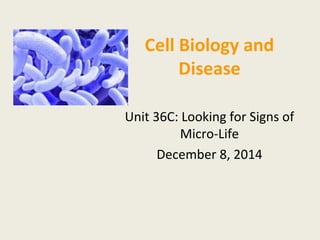Activity 36 c looking for signs of micro life
•Download as PPT, PDF•
0 likes•827 views
Looking at both prepared slides and living samples of microbes under the microscope.
Report
Share
Report
Share

Recommended
Recommended
More Related Content
Similar to Activity 36 c looking for signs of micro life
Similar to Activity 36 c looking for signs of micro life (20)
Talk by Jonathan Eisen "The Rise of the Microbiome: Challenges and Opportunit...

Talk by Jonathan Eisen "The Rise of the Microbiome: Challenges and Opportunit...
More from ddegennaro
More from ddegennaro (14)
Activity 15 b digestion an absorbing tale ccss science&literacy

Activity 15 b digestion an absorbing tale ccss science&literacy
Recently uploaded
Recently uploaded (20)
Beyond_Borders_Understanding_Anime_and_Manga_Fandom_A_Comprehensive_Audience_...

Beyond_Borders_Understanding_Anime_and_Manga_Fandom_A_Comprehensive_Audience_...
Simple, Complex, and Compound Sentences Exercises.pdf

Simple, Complex, and Compound Sentences Exercises.pdf
HMCS Max Bernays Pre-Deployment Brief (May 2024).pptx

HMCS Max Bernays Pre-Deployment Brief (May 2024).pptx
dusjagr & nano talk on open tools for agriculture research and learning

dusjagr & nano talk on open tools for agriculture research and learning
Python Notes for mca i year students osmania university.docx

Python Notes for mca i year students osmania university.docx
21st_Century_Skills_Framework_Final_Presentation_2.pptx

21st_Century_Skills_Framework_Final_Presentation_2.pptx
Activity 36 c looking for signs of micro life
- 1. Cell Biology and Disease Unit 36C: Looking for Signs of Micro-Life December 8, 2014
- 2. Activity 36C: Looking for Signs of Micro-Life December 8, 2014 Getting Started: How could you figure out if something is a microbe? Introduction: Read pg.C-27 RACE: What makes people sick? L ooking for Signs of Microbe-Life If someone asked you what makes you sick, you might answer that germs, bacteria, or viruses make you sick. During the early 1900’s, some people thought an infectious disease like th flu could be caused by nakedness, contaminated food, irritating gases in the atmosphere, unclean clothing, open windows, closed windows, old books, dirt, dust, or supernatural causes. What does cause infectious diseases? You can… What kinds of microbes can you find? 36C Challenge: Rewrite the challenge question in your own words.
- 3. Key Words: disease, microbe Procedure: Have you read and do you understand the procedure on pg. C-28? Write one sentence that describes what you will be doing. Results: Common Microbes Drawing Organizer 35.3 Discussing our results Analysis: Answer Analysis Questions 1 through 5. Reflection: Imagine that you are a researcher studying microbes. Would you choose to study a disease causing microbe or one that does not cause disease? Explain you reasoning.
- 6. Discussion of observations • What characteristics did you look for to determine if something was a microbe?
- 7. • Could something that doesn’t move still be alive?
- 8. • Were plants or algae moving?
- 9. • Is it possible some microbes exist that are smaller then we can observe? How could we collect evidence to prove or disprove your theory?
- 10. Where would you expect to find microbes and what do you think they might be doing there? • Most microbes are free-living (non-parasitic) • They live on almost every environment on Earth, including: – Inside rocks - in hot springs – In the soil - crude oil • They are vital parts of the food web – decomposers - scavengers – Carnivores - herbivores – Parasites - producers
- 11. Bacteria Cell Structure • Cell Wall • Cell Membrane • Cytoplasm • Ribosomes – produce protein • No Nucleus; genetic material floats in the cytoplasm • Shape – Rod – Sphere – Spiral
- 12. Bacteria v Animal Cells Bacteria Cells
- 13. Question 2 • Develop three rules you will use the next time you do microscopy drawings: 1. Make an exact copy of what you see 2. Do not draw everything you see. 3. Label the drawing. 4. Give the magnification. 5. Focus on the object with low power before using high power.
- 14. Question 3 As a scientist, you are asked to describe two of the microbes that you saw to someone who has never looked through a microscope. Write a short paragraph describing the microbes you observed.